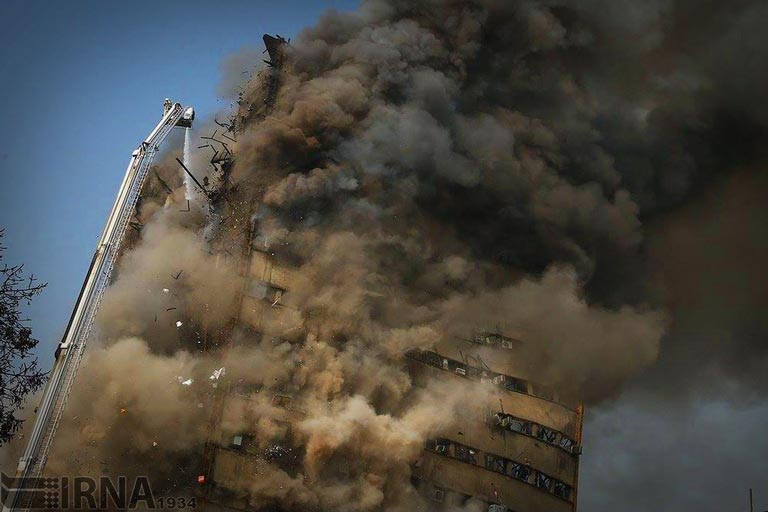On January 19, 2018, the one-year anniversary of the Plasco Building collapse in Iran, the website Gizmodo published an article by structural engineer Alex Weinberg titled “Why 9/11 Truthers Are Obsessed with the Plasco High-Rise Fire in Tehran.”
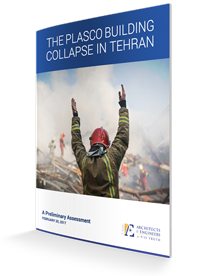 The focus of Weinberg’s article was the response of Architects & Engineers for 9/11 Truth (AE911Truth) — the organization I work for — to the destruction of Tehran’s first-ever, iconic high-rise. At around 8:00 AM that day, the upper floors caught fire and burned for a little over three hours before a series of explosions rocked the building. The structure then completely collapsed to the ground, tragically claiming the lives of sixteen firefighters and six civilians.
The focus of Weinberg’s article was the response of Architects & Engineers for 9/11 Truth (AE911Truth) — the organization I work for — to the destruction of Tehran’s first-ever, iconic high-rise. At around 8:00 AM that day, the upper floors caught fire and burned for a little over three hours before a series of explosions rocked the building. The structure then completely collapsed to the ground, tragically claiming the lives of sixteen firefighters and six civilians.
The day after, we issued a statement, based on our analysis of the available videos, urging the Iranian government to investigate the possible use of explosives. One month later, after compiling more evidence, we published a report recommending that investigators consider explosives and incendiaries as the primary hypothesis for the building’s destruction. Our purpose was “to help the people of Iran in their effort to understand the cause of this tragic incident.”
Fast-forward one year later to the first anniversary. Within an hour after we released a video to bring attention to the issue (the video is available in English and Farsi), Alex Weinberg’s hate-fest of an article was published. I use the term “hate-fest” not only because the article is unabashedly derisive and dehumanizing, but because Weinberg openly admitted his disdain of “9/11 conspiracy theorists” in an article he penned on the sixth anniversary of 9/11, in which he wrote:
“To them, airplane collisions could not have toppled the Twin Towers, and something else must have led to the unprecedented destruction. Let me just say that I take deep offense at this idea. Conservative commentators often deride 9/11 conspiracy theorists for their lack of patriotism or compassion or whatever, but I think this is a far too easy way of thinking. Instead, I hate them for the much more substantiative sin of being stupid and loud. To me — a structural engineering student and longtime supporter of skyscrapers and skyscraper-related causes — they might as well be protesting against evolutionary theory or the abstract notion of time.”
Weinberg’s stated reason for hating “9/11 conspiracy theorists” is odd when you consider that many of the architects and engineers who’ve signed the petition of AE911Truth did so because they view the official account of the World Trade Center’s destruction as an affront to their profession. Three skyscrapers collapsed completely and catastrophically in one day, killing more than 2,500 people, ostensibly under design load conditions (that is, conditions the structures were designed to withstand). Proving that the Twin Towers and World Trade Center 7 did not actually collapse from fire would therefore absolve the building professions of negligence, or at least that is how some members of these professions see it. In reality, it seems that Weinberg’s hatred is borne out of something much deeper than his love of skyscrapers.
Whatever that something may be, his 2007 rant reveals unambiguously that he is deeply invested in the official account of the World Trade Center’s destruction, so much so that it has become his ideology and he despises those who question it. How ironic, then, that in his Gizmodo piece he would call AE911Truth the only group of Americans “ideologically invested” enough to pay attention to the Plasco Building incident.
The central thesis of Weinberg’s attempted psychoanalysis is that because AE911Truth “has spent the past decade convincing a brain trust of YouTube commenters that tall buildings simply cannot collapse due to fire,” “rather than accepting the Plasco Building as a thundering rebuttal to their theories, AE911Truth concluded that Plasco was also a controlled demolition.”
First, let’s get one thing straight: AE911Truth has never argued that tall buildings “cannot” collapse due to fire, nor have any of the architects, engineers, or scientists affiliated with AE911Truth, as far as I’m aware. The undisputed fact we cite is that, putting aside the issue of the World Trade Center’s destruction (and now the Plasco incident), no steel-framed high-rise has ever completely collapsed due to fire.
Occasionally, some architects and engineers will make the bolder statement that steel-framed high-rises do not collapse due to fire. Scott Grainger, a Fellow of the Society of Fire Protection Engineers, states as much in our signature documentary 9/11: Explosive Evidence — Experts Speak Out. But that is not the same as saying that tall buildings cannot collapse due to fire.
More to the point, it is not our central argument, or even a critical argument, that no steel-framed high-rise has ever collapsed from fire. The purpose of looking at the performance of steel-framed high-rises in large fires is to put the World Trade Center collapses in their proper context as highly anomalous events. If a steel-framed high-rise one day does succumb to fire, it will not change the fact that the fire-induced collapse of a steel-framed high-rise is an exceedingly rare and improbable occurrence. Nor would the instance of a single steel-framed high-rise collapsing from fire make the slightest dent in the overwhelming scientific evidence that the Twin Towers and World Trade Center 7 were destroyed by controlled demolition.
In other words, had the Plasco Building actually collapsed due to fire, it would not have been the “thundering rebuttal to [our] theories” that Alex Weinberg fantasizes. When we woke up on the morning of January 19, 2017, to the news that a burning high-rise in Iran had collapsed, we were not expecting to watch videos of the event and see signs that made it appear to be a controlled demolition. We started watching with curiosity, assuming that we were about to see footage of a fire-induced collapse, as reported. If it had turned out to be a fire-induced collapse, we would’ve simply updated our materials to reflect the fact that one steel-framed high-rise in the long history of high-rise construction had collapsed from fire.
But for people like Alex Weinberg, for whom I’m compelled to coin the term “demolition denier,” the question of the Plasco Building’s destruction means much more. Since no steel-framed high-rise has ever completely collapsed due to fire (putting aside the events of 9/11), the Plasco incident was a golden opportunity for Weinberg and his fellow deniers to say, “LOOK!!! Steel-framed high-rises can collapse due to fire!”
Weinberg acknowledges this very problem on his own: “Prior to Plasco, it was difficult to produce counterexamples that would immediately disprove these truther axioms because out-of-control high-rise fires just don’t happen very often.” Sorry, Alex. It turns out you’ll have to keep waiting for your first counterexample — when the ratio will then be one-collapse-to-however-many-hundreds-of-fires instead of zero-to-however-many-hundreds.
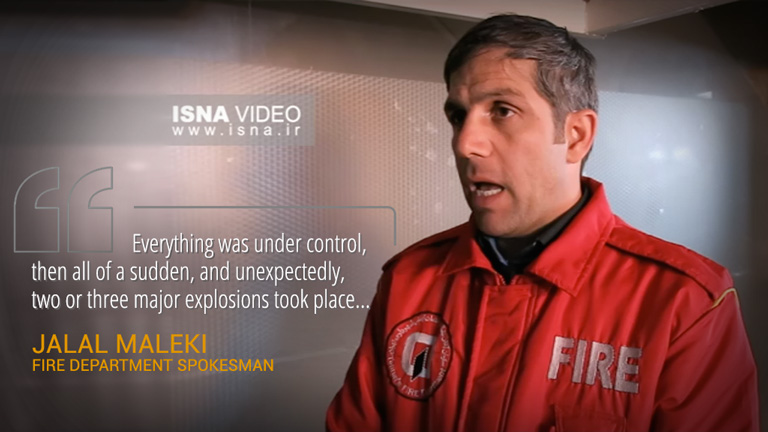 “Everything was under control, then all of a sudden, and unexpectedly, two or three major explosions took place in the upper floors at intervals of two or three minutes.” – Jalal Maleki, fire department spokesman
“Everything was under control, then all of a sudden, and unexpectedly, two or three major explosions took place in the upper floors at intervals of two or three minutes.” – Jalal Maleki, fire department spokesman
By the way, the Plasco fire was not “out-of-control” by the time of the building’s collapse, and I mean that in the most literal sense. According to fire department spokesman Jalal Maleki, “The extinguishing process was going pretty well. We were at the end of our job. Everything was under control, then all of a sudden, and unexpectedly, two or three major explosions took place in the upper floors at intervals of two or three minutes.” [Emphasis added.] If you want to know what an “out-of-control” fire looks like, take a look at this one, which happened in Mashhad, Iran, six months before the Plasco incident.
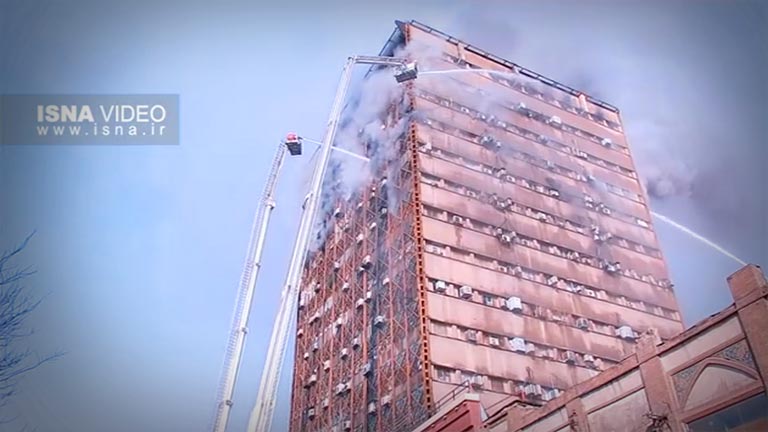 The fire department reported that the fire was under control and was being extinguished.
The fire department reported that the fire was under control and was being extinguished.
But back to Weinberg’s conundrum: Even more important to demolition deniers than their newfound ability to claim one fire-induced collapse is the severe damage that would be done to their ideology if they had to accept the Plasco incident as a demolition.
Perhaps a few demolition deniers saw the videos of explosions shooting out of the Plasco Building and thought to themselves, “Hmm, maybe this one was demolished.” But, if they did, they kept quiet and decided not to go against the orthodoxy being written by people like the Pope of Demolition Denial, Mick West. The very same day we released our initial statement, West published the article “AE911Truth Forced to Claim Plasco Collapse is an Inside Job.” A rational person would be able to separate the World Trade Center from the Plasco incident, but apparently demolition deniers saw Plasco as a threat to their ideology and couldn’t entertain the possibility that it was a controlled demolition.
As Weinberg observes, “The debates over Plasco’s collapse have raged in the same hundred page forum threads and YouTube comment sections as the 9/11 arguments of yesteryear.” Weinberg is mostly referring to the International Skeptics Forum, where “giddy debunkers,” as he calls them, go to spew the same vitriol he did on Gizmodo and where they occasionally debate the few 9/11 researchers brave enough and giving enough of their time to argue with them. Whereas demolition deniers have filled out “hundred page forum threads” debating the Plasco incident, most 9/11 Truth activists have not given it much time. Indeed, it is demolition deniers — not “9/11 truthers” — who are obsessed with the Plasco Building demolition.
And yet despite all the “hundred page forum threads” that Weinberg could have drawn from, his argument is tellingly light on facts. Why include only a single video of the Plasco collapse when there are so many others available, like this one or this one? Or, if he needed to keep it to one video, why not this one, which is a compilation of several videos? Was he afraid that if he were to show these videos to a larger audience, one outside of his “church,” that some readers would see the incident for what it was?
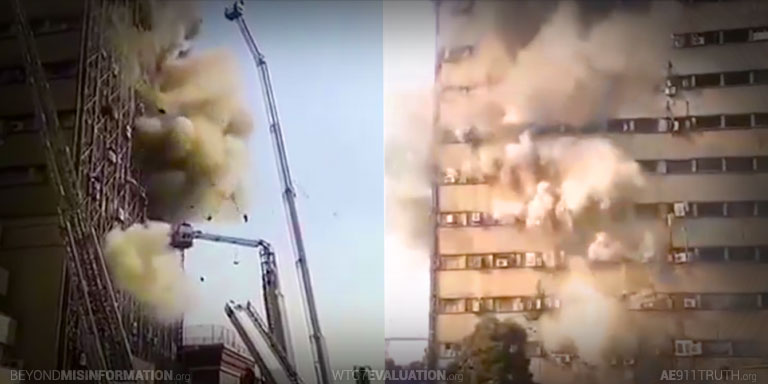 Explosions occurred below the fire after it had been brought under control.
Explosions occurred below the fire after it had been brought under control.
And why did he feel the need to exaggerate the severity of the fire? The fire “spread quickly.” It was “nearly unreachable.” The flames “finally overwhelmed the structure.” Actually, the fire was limited to the building’s upper floors and was thought by the fire department to have been extinguished when, as mentioned above, “two or three major explosions took place. . . .” Weinberg omits these critical facts. As a result, his less-informed readers will have no idea that Plasco was actually a fire and explosion incident, which is how it was treated by the media and politicians in Iran.
Weinberg predictably trots out an expert to add a semblance of scientific credibility to his pseudo-scientific sermon. But his expert exaggerates the extent to which steel loses strength when heated to given temperatures, saying: “At 450 degrees [Celsius] or so, you get basically a 50 percent drop in strength and stiffness, and that’s very significant.” In fact, as we cited in our report, structural steel “loses about half its strength at 650°C” (Eagar and Musso: Why Did the World Trade Center Collapse?). Weinberg exaggerates the matter still further by suggesting that well-ventilated office fires can reach an obscenely high 1,100°C, which — although technically possible — is exceedingly difficult to achieve and clearly not what occurred in the Plasco Building, given the fire’s lack of intensity documented in videos.
The matter of design redundancy — i.e., the ability of a structure to handle multiple times the load it is carrying so that isolated local failures will not cause the entire structure to collapse like a house of cards — is conspicuously absent from Weinberg’s article. As we explain in our report, “[V]irtually every column would need to be heated to 650°C at the same time, losing 50% of its strength, to present the risk of a building-wide failure. This would be very difficult to accomplish even in a raging fire.”
Moreover, Weinberg’s attacks on the report are so unfounded that it’s clear he either didn’t read it carefully or he was deliberately intending to misrepresent it to his readers.
For example, he complains, “Most of the links in footnotes of the paper point to YouTube videos and the organization’s own PDF documents.” The sixteen YouTube links he is referring to are straightforward videos of the collapse or of the debris pile (Weinberg thinks it’s better to show only one video) — or they are interviews with firefighters featuring English subtitles, which were translated and provided to us by an Iranian living in Iran. The nine PDF links he refers to, with the exception of one English-language news article, are clearly-sourced Farsi news reports, which our Iranian contact also translated to English for us and which contain a variety of important evidence. In other words, the very thing Weinberg holds up to demonstrate our purported lack of rigorous research is actually a demonstration of the kind of rigor that Weinberg either willfully avoided or never even thought to attempt.
The fact of the matter is that Weinberg doesn’t care about finding the truth. The only reason the Plasco tragedy seems to mean anything to him is that it’s a threat to his demolition denial, and so he must turn it around and attempt to use it as ammunition against those who challenge his belief system. He pays lip service to the victims of the tragedy, writing, “Tens of thousands of citizens publicly mourned the firefighters when they were laid to rest,” but it’s just that, lip service.
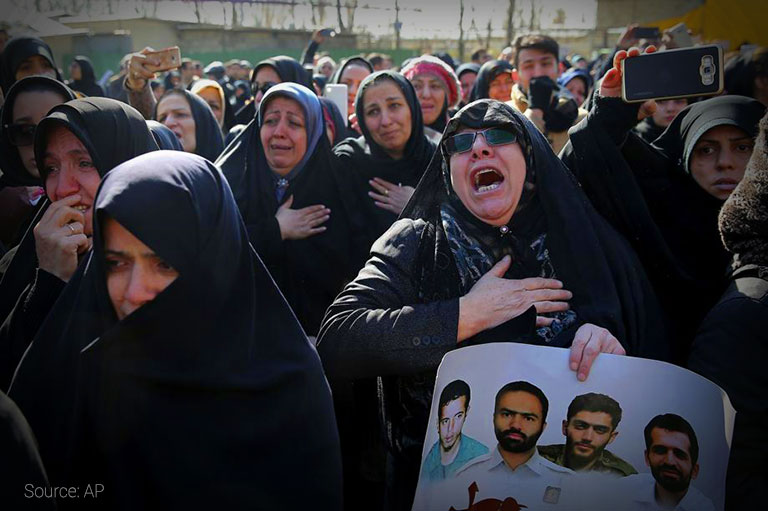 Thousands gathered in Tehran to mourn the victims of the Plasco tragedy.
Thousands gathered in Tehran to mourn the victims of the Plasco tragedy.
If Weinberg actually cared, he would have interviewed someone from Iran, maybe a witness, maybe a victim’s family member, maybe the person who provided our video and article translations, or maybe the Iranian (also based in Iran) who volunteered, unsolicited, to translate the report into Farsi. Maybe he would have learned from these interviews that a large percentage of Iranians believe that the Plasco Building was demolished — a majority of them, according to our contacts. Maybe he would have found that this is also the position of Iran’s most popular reformist news site, Amad News, which has over one million followers on Telegram and which published both the English and Farsi versions of our report.
Of course, he didn’t do all of this because the ideology of demolition denial, to which he subscribes so fervently, is one founded on arrogance, self-delusion, and above all, a fear of any information that might undermine the ideology. The result is a callous lack of genuine interest in justice for the victims of mass murder — first the one on September 11, 2001, and now the one on January 19, 2017.
Demolition denial wouldn’t matter so much if it were espoused only by a small group of devout followers. But the reason it’s so damaging to society is that it’s also adhered to by many in the Western media. They’re not regular “churchgoers” (i.e., they don’t visit the International Skeptics Forum), but they are still firm believers. They mock the architects, engineers, and scientists who expose the falsity of their dogma and they give over-zealous preachers like Weinberg a pulpit to reinforce the faith.
The disastrous effect of their demolition denial has been to prevent justice for the victims of 9/11 for more than sixteen years while continuing to prop up the endless “War on Terror.” Now demolition denial has reared its ugly head again, causing the mass murder of twenty-two people in the Plasco Building demolition to go almost entirely unnoticed outside of Iran.
Ted Walter is the director of strategy and development for Architects & Engineers for 9/11 Truth (AE911Truth). In 2015, he authored AE911Truth’s Beyond Misinformation: What Science Says About the Destruction of World Trade Center Buildings 1, 2, and 7, and in 2016, he authored AE911Truth’s World Trade Center Physics: Why Constant Acceleration Disproves Progressive Collapse. He holds a Master of Public Policy degree from the University of California, Berkeley.


